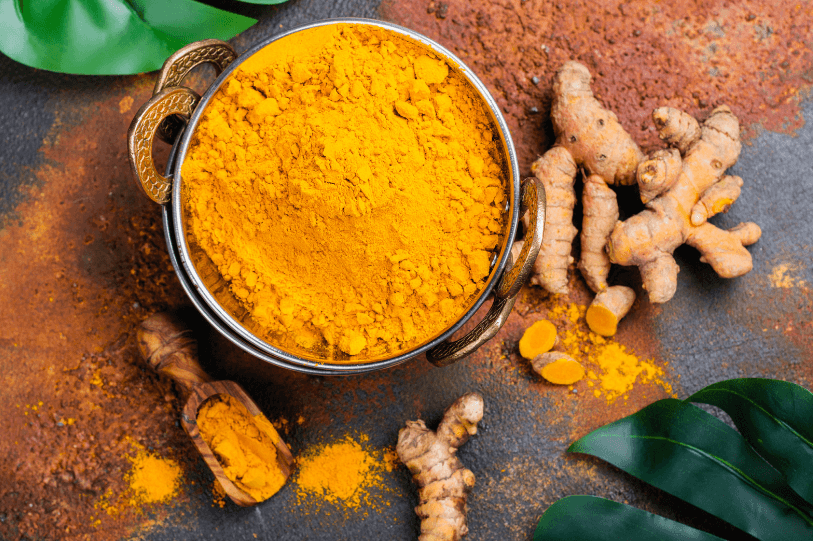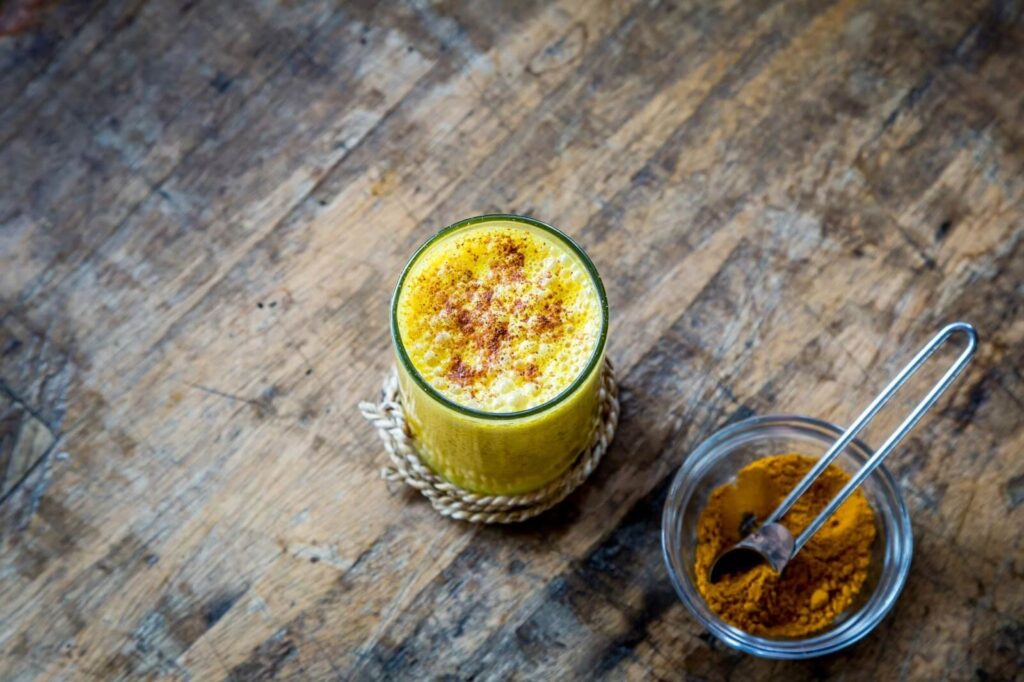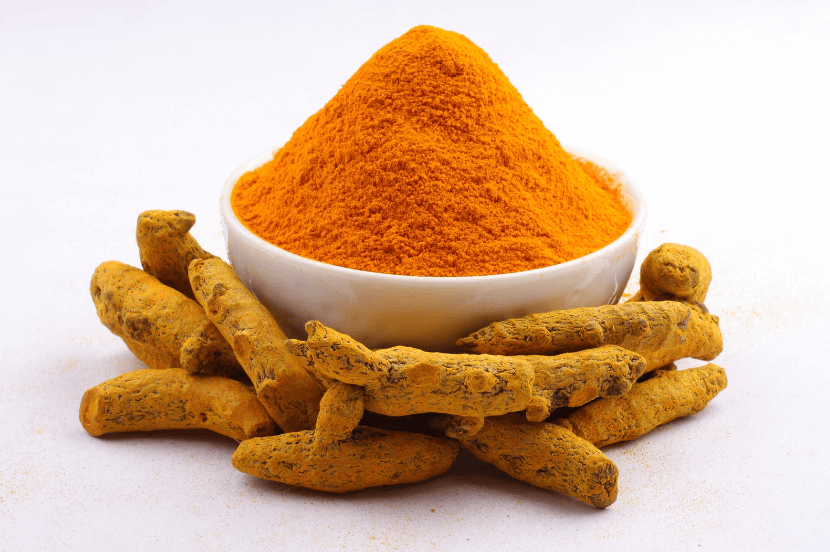Turmeric may help with headaches, particularly those caused by inflammation, like migraines, due to its potent anti-inflammatory properties. The primary compound in turmeric, curcumin, is known to reduce inflammation, which is a key factor in migraine attacks and other headaches. I
While direct evidence linking turmeric to headache relief is limited, curcumin’s ability to inhibit pro-inflammatory pathways offers potential benefits for those suffering from headaches, particularly migraines.
Does Turmeric Help with Headaches?
Migraines are debilitating headaches characterized by severe pain, sensitivity to light and sound, nausea, and even visual disturbances. Managing migraines is challenging, and people often seek alternative treatments to avoid the side effects of medications.
Turmeric supplements have been suggested as a natural remedy, primarily due to their active compound, curcumin, which exhibits strong anti-inflammatory and antioxidant properties.
Curcumin is believed to influence several pathways involved in neurogenic pain and inflammation, making it a potential tool to relieve migraine symptoms. The inflammation in blood vessels and nerves during a migraine attack can increase pain and discomfort.
Since curcumin targets inflammation, there is a growing belief that turmeric could alleviate migraine pain.
Turmeric and Migraine

Though turmeric’s anti-inflammatory properties are well-documented, specific research on its use for chronic migraine is limited. However, there are several studies on curcumin’s role in reducing inflammation and pain, which indirectly support the theory that it could help with migraines.
- A study published showed that curcumin has the ability to inhibit pro-inflammatory cytokines, molecules involved in the inflammatory response, which could help treat migraine attacks (Rahimian et al., 2019). Since inflammation plays a crucial role in the onset of migraines, this could explain why turmeric might help.
- Another study conducted on patients with chronic inflammatory diseases like arthritis—conditions also linked with inflammation—revealed that curcumin supplementation reduced pain levels in participants (Daily et al., 2016). Although this study was not specific to migraines, the results suggest curcumin’s potential to alleviate pain in conditions involving inflammation.
Overall, while there isn’t direct evidence showing turmeric as a definitive cure, its anti-inflammatory effects may be beneficial for managing migraine pain and could be considered part of an herbal therapy approach.
Migraine Common Triggers
Common triggers include:
- Stress and emotional strain
- Hormonal changes (e.g., menstruation, menopause)
- Lack of sleep or irregular sleep patterns
- Dehydration
- Certain foods (e.g., processed meats, aged cheeses, alcohol)
- Environmental factors (e.g., bright lights, loud sounds, strong odors)
- Weather changes, especially shifts in barometric pressure
Which Is Better, Supplementary or Dietary Turmeric?
Migraine headaches can significantly impact human health. Generally speaking, obtaining nutrients from your diet is preferable to taking supplements. That being said, you’ll probably want a greater dosage of those anti-inflammatory drugs if your head is exploding with agony during migraine attacks. Here’s where supplements come into play.
Turmeric is a natural remedy renowned for its anti-inflammatory properties. While it’s found in food at a lower level than in most supplements, incorporating it into your meals might not provide sufficient relief for migraine symptoms. This is particularly true for those experiencing severe migraine attacks.
You may cook with black pepper and other substances that enhance your body’s absorption of turmeric. Similarly, when purchasing supplements, make sure the goods have bioavailability agents included. Understanding these factors can be crucial in managing critical risk factors associated with migraine headaches.
Ways to improve absorption so that turmeric may be used for migraines and headaches more successfully :
Primary headache disorders, including migraine headache, can be challenging to manage. Because turmeric passes through the digestive system fast, it is not easily absorbed into the circulation. However, you may aid in boosting its absorption in two ways, which could be beneficial for those seeking relief from headache pain:
- Check if the supplement contains chili powder, cayenne pepper, or black pepper. Each has piperine as an active component. Although piperine is a potent antioxidant and anti-inflammatory on its own, its primary advantage in this case is that it increases curcumin’s absorption. This could be particularly relevant for individuals participating in a clinical trial for migraine headache treatments.
- Since curcumin is fat soluble, absorption will also be enhanced if it is taken with an omega-3 fatty acids supplement, ghee, or any food that contains a lot of good fat. This enhanced absorption could be crucial for those seeking fast relief from a tumeric headache, which is a common issue in primary headache disorders.
These methods may help improve the efficacy of turmeric in managing headache pain, though more clinical trial data is needed to fully understand its potential in treating migraine headache and other primary headache disorders.
Benefits of Turmeric

Turmeric offers a broad spectrum of health benefits, many of which are backed by extensive research. Its anti-inflammatory compounds and antioxidant properties make it a powerful tool in promoting overall health. Below are some of the key benefits of turmeric:
1. Anti-inflammatory Effects
Curcumin, turmeric’s most active compound, has been widely studied for its potent anti-inflammatory properties. Inflammation is a core factor in several chronic diseases, including arthritis, cardiovascular disease, and even migraines.
By inhibiting inflammatory pathways, turmeric may reduce overall inflammation, potentially lowering the frequency and severity of migraine triggers and migraine attacks.
2. Antioxidant Properties
Turmeric is also a strong antioxidant, helping to neutralize harmful free radicals that can cause oxidative stress and lead to cellular damage. This is important in the context of migraines, as oxidative stress can exacerbate headache symptoms. By reducing oxidative damage, turmeric might help mitigate migraine triggers.
3. Pain Relief
In addition to reducing inflammation, curcumin is also believed to affect neurotransmitters involved in the sensation of pain. Studies have shown that turmeric can reduce pain in conditions like osteoarthritis, suggesting that it might offer relief for migraine pain and other headaches too.
4. Supports Brain Health
There is emerging evidence that curcumin may enhance cognitive function and protect brain cells from degeneration. Given that migraines can be linked to neurological imbalances, turmeric’s neuroprotective effects could indirectly contribute to better headache and migraine prevention.
What Other Natural Remedies May Help Migraines?
While turmeric holds potential as a natural pain reliever for headaches, it’s not the only option. Several other herbal remedies may offer migraine relief:
1. Magnesium
Magnesium deficiency has been linked to migraines, and supplementation has shown promise in reducing migraine attack frequency. Studies have found that taking magnesium supplements can help prevent migraine attacks in individuals with low magnesium levels (Mauskop & Varughese, 2012).
2. Riboflavin (Vitamin B2)
Research suggests that riboflavin can reduce the frequency of migraines when taken as a daily supplement. It is believed to enhance energy production in brain cells, potentially reducing the occurrence of migraine triggers.
3. Peppermint Oil
Applying peppermint oil to the temples can provide headache relief for some individuals. The menthol in peppermint oil has a cooling effect and may reduce muscle tension, which can be a trigger for intense headaches and tension headaches.
4. Ginger
Like turmeric, ginger has anti-inflammatory properties. Some studies have shown that ginger can reduce migraine symptoms when taken at the onset of an attack, much like turmeric and curcumin capsules.
5. Feverfew
Feverfew is a traditional herb used to prevent migraines. Some research suggests it may reduce migraine frequency, although results are mixed. It’s thought to work by inhibiting the release of inflammatory substances in the brain that contribute to clinical symptoms of migraines.
How to Use Turmeric for Headache

Turmeric, with its significant anti-inflammatory qualities, shows promise as a natural cure for headaches, including migraines. Here are some methods to integrate turmeric into your daily routine for headache relief:
Turmeric Tea
Make a cup of turmeric tea by combining a teaspoon of turmeric powder and a cup of boiling water. You may boost its efficiency by adding a sprinkle of black pepper, which assists in the absorption of curcumin, turmeric’s active ingredient. Some migraine patients report a significant decrease in headache frequency with regular consumption.
Turmeric Golden Milk
To make a calming turmeric golden milk, combine turmeric powder with warm milk (dairy or plant-based) and a drizzle of honey or maple syrup for sweetness. This soothing beverage not only relieves headaches but also promotes relaxation and improved sleep. The combination of ingredients may help boost antioxidant enzymes in the body.
Turmeric Smoothie
Add turmeric powder to your morning smoothie, along with fruits, leafy greens, and a source of healthy fats such as avocado or coconut milk. This is a healthful and tasty way to add turmeric to your diet while also alleviating headaches. Clinical trials suggest that regular intake may help manage inflammatory factors associated with migraines.
Turmeric Capsules
For a more convenient approach, turmeric capsules or curcumin supplements are available. Make sure they include black pepper extract or piperine to improve absorption. This method may be particularly suitable for migraine patients dealing with a chronic and lifelong disease.
Turmeric Paste
Combine turmeric powder with water or oil to produce a thick paste. For localized headache relief, apply it topically to the forehead or temples. Some users report a significant decrease in pain intensity with this method.
Turmeric in Cooking
Mix turmeric into soups, stews, stir-fries, and curries. To maximize absorption, pair it with black pepper and healthy fats. Regular consumption through diet may help boost antioxidant enzymes and reduce inflammatory factors associated with headaches.
Remember, while these methods show promise, it’s important for migraine patients to consult with healthcare professionals, especially when dealing with a chronic and lifelong disease like migraines.
Other Ways to Relieve Migraine
1. Hydration
Dehydration is a common trigger for headaches. Ensuring adequate fluid intake, particularly water, can help relieve migraine and prevent headaches.
2. Adequate Sleep
Lack of sleep can worsen headache symptoms. Establishing a regular sleep routine and aiming for 7–9 hours of sleep per night can reduce the frequency of headaches and prevent migraine attacks.
3. Stress Management
Chronic stress is a major trigger for headaches, especially tension headaches. Techniques like meditation, yoga, and deep breathing exercises can help lower stress levels and reduce headache occurrences.
4. Regular Physical Activity
Regular physical exercise can minimize the chance of headaches by increasing circulation, lowering stress, and improving general well-being.
5. Dietary Adjustments
Identifying and avoiding dietary migraine triggers, such as caffeine, alcohol, and processed foods, can significantly reduce headache frequency.
Potential Side Effects of Turmeric
While turmeric is generally safe for most people, high doses or prolonged use can lead to some side effects, including:
- Gastrointestinal issues: Turmeric can cause stomach upset, nausea, or diarrhea, especially in high doses.
- Blood thinning: Turmeric may slow blood clotting, which can increase the risk of bleeding, particularly for individuals on blood-thinning medications.
- Gallbladder issues: People with gallstones or bile duct obstruction should avoid turmeric, as it can exacerbate these conditions.
Special Precautions and Warnings
Certain individuals should exercise caution when using turmeric, including:
- Pregnant and breastfeeding women: Although turmeric is likely safe when consumed in food amounts, supplements should be avoided due to the lack of safety data.
- Individuals with bleeding disorders: Since turmeric may slow blood clotting, it should be avoided by individuals with bleeding disorders or those preparing for surgery.
- People with gallbladder issues: Turmeric can worsen gallbladder problems, such as gallstones.
FAQ
Does Turmeric Get Rid of Headaches?
While turmeric may not “cure” headaches, its anti-inflammatory compounds can help reduce the severity and frequency of headaches, particularly those related to inflammation, such as migraines.
What Is the Safest Remedy for a Headache?
Hydration, adequate sleep, stress management, and dietary adjustments are some of the safest ways to manage headaches. Turmeric supplements may also be a safe and natural option for those seeking relief from migraine pain and inflammation.
Does Turmeric Work Like Ibuprofen?
While turmeric and ibuprofen both have anti-inflammatory effects, they function in different ways. Turmeric offers long-term benefits in reducing inflammation, while ibuprofen is typically used as a preemptive analgesic to relieve acute migraine pain.
Conclusion
Turmeric has shown potential as a natural remedy for migraine relief and intense headaches. Its anti-inflammatory compounds make it an attractive option for those seeking herbal therapy to complement other treatments.
While more research is needed, curcumin supplementation may offer additional health benefits beyond headache relief. Always consult with a healthcare provider before starting any new supplement, particularly if you have underlying health conditions or are taking medications.
If you enjoyed this article, you may also want to read this article How Does Turmeric Help with Colds?
*This information is not intended to serve as a substitute for professional medical or dietary advice tailored to individual needs.
Dr. Nicolette Natale is a physician, with a background in Psychology, General Medicine, and English Literature, combining her expertise to provide readers with the most accurate, easy-to-understand, and comprehensive information regarding healthcare. She received her Doctorate in Osteopathic Medicine from Nova Southeastern University, and her bachelor’s in English Literature and Psychology from the University of Miami. Dr. Natale seeks to empower individuals with knowledge, fostering a greater understanding of holistic health and encouraging a proactive approach to well-being




